Antibody data
- Antibody Data
- Antigen structure
- References [1]
- Comments [0]
- Validations
- Immunocytochemistry [4]
- Immunohistochemistry [4]
- Other assay [1]
Submit
Validation data
Reference
Comment
Report error
- Product number
- PA5-55754 - Provider product page

- Provider
- Invitrogen Antibodies
- Product name
- DHX9 Polyclonal Antibody
- Antibody type
- Polyclonal
- Antigen
- Recombinant protein fragment
- Description
- Immunogen sequence: PHLALKAENN SEVGASGYGV PGPTWDRGAN LKDYYSRKEE QEVQATLESE EVDLNAGLHG NWTLENAKAR LNQYFQKEKI QGEYKYTQVG PDHNRSF Highest antigen sequence identity to the following orthologs: Mouse - 95%, Rat - 94%.
- Reactivity
- Human, Mouse, Rat
- Host
- Rabbit
- Isotype
- IgG
- Vial size
- 100 μL
- Concentration
- 0.05 mg/mL
- Storage
- Store at 4°C short term. For long term storage, store at -20°C, avoiding freeze/thaw cycles.
Submitted references Involvement of DHX9/YB-1 complex induced alternative splicing of Krüppel-like factor 5 mRNA in phenotypic transformation of vascular smooth muscle cells.
Huan W, Zhang J, Li Y, Zhi K
American journal of physiology. Cell physiology 2019 Aug 1;317(2):C262-C269
American journal of physiology. Cell physiology 2019 Aug 1;317(2):C262-C269
No comments: Submit comment
Supportive validation
- Submitted by
- Invitrogen Antibodies (provider)
- Main image
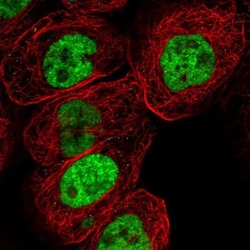
- Experimental details
- Immunofluorescent staining of DHX9 in human cell line A-431 shows positivity in nucleus but excluded from the nucleoli. Samples were probed using a DHX9 Polyclonal Antibody (Product # PA5-55754).
- Submitted by
- Invitrogen Antibodies (provider)
- Main image
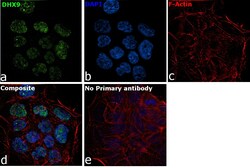
- Experimental details
- Immunofluorescence analysis of DHX9 was performed using A-431 cells. The cells were fixed with 4% paraformaldehyde for 10 minutes, permeabilized with 0.1% Triton™ X-100 for 15 minutes, and blocked with 2% BSA for 1 hour at room temperature. The cells were labeled with DHX9 Polyclonal Antibody (Product # PA5-55754) at 4 microgram/mL in 0.1% BSA, incubated at 4 degree Celsius overnight and then labeled with Goat anti-Rabbit IgG (H+L) Superclonal™ Secondary Antibody, Alexa Fluor® 488 conjugate (Product # A27034) at a dilution of 1:2000 for 45 minutes at room temperature (Panel a: green). Nuclei (Panel b: blue) were stained with ProLong™ Diamond Antifade Mountant with DAPI (Product # P36962). F-actin (Panel c: red) was stained with Rhodamine Phalloidin (Product # R415, 1:300). Panel d represents the merged image showing nuclear localization. Panel e represents control cells with no primary antibody to assess background. The images were captured at 60X magnification..
- Submitted by
- Invitrogen Antibodies (provider)
- Main image
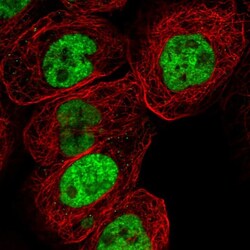
- Experimental details
- Immunofluorecent analysis of DHX9 in human cell line A-431 using DHX9 Polyclonal Antibody (Product # PA5-55754). Staining shows localization to nucleoplasm.
- Submitted by
- Invitrogen Antibodies (provider)
- Main image
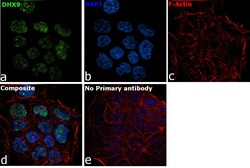
- Experimental details
- Immunofluorescence analysis of DHX9 was performed using A-431 cells. The cells were fixed with 4% paraformaldehyde for 10 minutes, permeabilized with 0.1% Triton™ X-100 for 15 minutes, and blocked with 2% BSA for 1 hour at room temperature. The cells were labeled with DHX9 Polyclonal Antibody (Product # PA5-55754) at 4 microgram/mL in 0.1% BSA, incubated at 4 degree Celsius overnight and then labeled with Goat anti-Rabbit IgG (Heavy Chain) Superclonal™ Secondary Antibody, Alexa Fluor® 488 conjugate (Product # A27034) at a dilution of 1:2000 for 45 minutes at room temperature (Panel a: green). Nuclei (Panel b: blue) were stained with ProLong™ Diamond Antifade Mountant with DAPI (Product # P36962). F-actin (Panel c: red) was stained with Rhodamine Phalloidin (Product # R415, 1:300). Panel d represents the merged image showing nuclear localization. Panel e represents control cells with no primary antibody to assess background. The images were captured at 60X magnification..
Supportive validation
- Submitted by
- Invitrogen Antibodies (provider)
- Main image
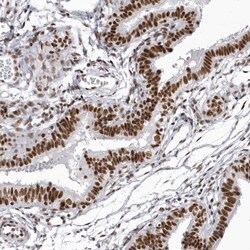
- Experimental details
- Immunohistochemical analysis of DHX9 in human fallopian tube using DHX9 Polyclonal Antibody (Product # PA5-55754) shows strong nuclear positivity in glandular cells.
- Submitted by
- Invitrogen Antibodies (provider)
- Main image
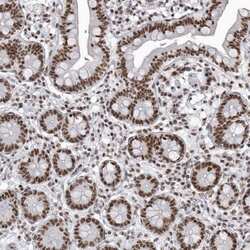
- Experimental details
- Immunohistochemical analysis of DHX9 in human small intestine using DHX9 Polyclonal Antibody (Product # PA5-55754) shows strong nuclear positivity in glandular cells.
- Submitted by
- Invitrogen Antibodies (provider)
- Main image
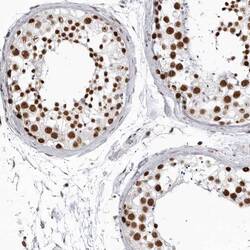
- Experimental details
- Immunohistochemical analysis of DHX9 in human testis using DHX9 Polyclonal Antibody (Product # PA5-55754) shows strong nuclear positivity in cells in seminiferous ducts.
- Submitted by
- Invitrogen Antibodies (provider)
- Main image
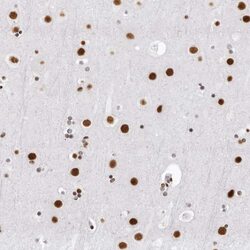
- Experimental details
- Immunohistochemical analysis of DHX9 in human cerebral cortex using DHX9 Polyclonal Antibody (Product # PA5-55754) shows strong nuclear positivity in neurons.
Supportive validation
- Submitted by
- Invitrogen Antibodies (provider)
- Main image
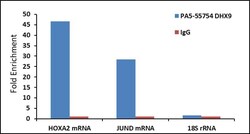
- Experimental details
- Detection of binding of endogenous DHX9 protein to specific RNA using Anti-DHX9 Antibody: RNA Immunoprecipitation (RIP) was performed using Anti-DHX9 Recombinant Rabbit Polyclonal Antibody (Product # PA5-55754, 5 ug) on whole cell lysate from 2 million HCT 116 cells. Normal Rabbit IgG was used as a negative IP control. RNA purified by RiboPure™ RNA Purification Kit (Product # AM1924) was analyzed by RT-PCR using the Power SYBR® Green RNA-to-CT™ 1-Step Kit (Product # 4389986) with RIP primer pairs over HOXA2, JUND mRNA and 18s rRNA. Data is presented as fold enrichment of the antibody signal versus the negative control IgG using the comparative CT method.
 Explore
Explore Validate
Validate Learn
Learn Western blot
Western blot Immunocytochemistry
Immunocytochemistry